AI-Driven Simulations Build Decision-Making Skills
- At Queen Mary University of London, students in a Strategic Analysis and Practice module run a business simulation as a way to develop key employability skills.
- Students first use AI for low-stakes assignments such as creating mission statements, before employing it for more complex tasks such as generating and evaluating strategic solutions.
- In their final reports, students reflect on how using AI tools has contributed to their learning process and enhanced their ability to make critical business decisions.
As artificial intelligence (AI) becomes increasingly prevalent in the business world, business schools are seeking creative ways to teach students how to use it. At Queen Mary University of London’s School of Business and Management, we are enhancing students’ AI literacy with a framework designed to help educators embed AI into their teaching. In this three-part model, developed by Xue Zhou and Lilian Schofield of Queen Mary University, students advance from foundational to intermediate to advanced levels of competency with AI.
I am the program director for Year 3 of the BSc of Business Management and one of the first to incorporate AI into the classroom. I recently piloted Zhou and Schofield’s model in Strategic Analysis and Practice, a core third-year module that I teach. Because students arrive in my class with some basic knowledge of AI, I started at level three of the framework. At this level, students use AI for higher-order activities such as creating and evaluating.
For the pilot, I utilized a simulation from Edumundu called Phone Ventures, which requires students to think strategically and make critical operational decisions that bring a company to life.
To enhance the experiential learning aspect of the simulation, I adopted a competition element in which five-person student teams competed with their peers as they operated their simulated companies. Over the five weeks of the competition, students learned to make collective decisions within their teams. They also developed key employability skills such as negotiation, problem-solving, teamwork, and adaptability.
During the simulation, I introduced the concept of “co-creating with AI.” My goal was to enhance students’ understanding of how AI can support decision-making by boosting their critical thinking and accelerating their ability to make accurate decisions. These are skills they will require to meet the evolving demands of the job market in today’s AI-driven world.
A Four-Part Approach
When integrating AI into the simulation, I used a four-part scaffolding approach to help students progressively build their skills and confidence in using AI effectively:
1. Orientation and preparation. For an AI-based simulation to be successful, it’s essential for everyone to have equal access to AI tools. At our school, all students have access to Microsoft Copilot through their university email. In addition, because students arrive in the classroom with varying levels of digital skills, it’s essential that they all know how to use these AI tools. I created a step-by-step visual guide to Microsoft Copilot, and I uploaded an instructional video and the simulation handbook to the module page.
Before the competition started, I had students complete two trial rounds to build their confidence and familiarize themselves with the mechanics of the simulation platform. This stage was crucial, as many students were experiencing simulation-based learning for the first time.
2. AI integration. Once students finished the trial rounds and began the simulation in earnest, I encouraged them to leverage AI tools such as Microsoft Copilot and ChatGPT. In the initial stages, students used AI for lower-stakes tasks such as generating mission statements; designing logos; and analyzing their companies for strengths, weaknesses, opportunities, and threats.
The complexity of the Phone Ventures simulation increased during the competition rounds as new marketplaces opened up every week. As their companies faced new internal and external challenges, students had to adjust their strategies as they faced more difficult operational choices. This prompted them to collaborate more deeply with AI so they could make quicker and more accurate decisions.
I challenged students to develop their critical thinking by answering reflective questions: Are AI responses valid and helpful? What problems are you facing with AI-generated solutions?
3. Hands-on co-creation. In the last two rounds of competition, students used AI to analyze data from the simulation, which enabled them to generate and evaluate strategic solutions.
As an example, many groups faced penalties because they couldn’t meet the demands of the market as they expanded their businesses into different territories. To generate potential solutions, students were guided to write effective prompts and select relevant data sets from the simulation. Some students chose to review the current levels of supply as well as potential delivery times. Then they used AI to predict demand from each country, which helped them make more informed decisions about resource allocation and market strategy.
I also encouraged students to assess the quality of the information AI presented. I wanted them to compare different prompts and different tools to evaluate the various responses that had been generated.
4. Reflection and assessment. I challenged students to develop their critical thinking by answering reflective questions: Are AI responses valid and helpful? What problems are you facing with AI-generated solutions? How can your group use the AI suggestions effectively?
In their final individual reports, students had to reflect on the personal development they had experienced during the simulation. They were asked to demonstrate how using AI tools had contributed to their learning process and enhanced their strategic decision-making skills.
Lessons and Suggestions
After running the pilot, I have concluded that using an AI-supported simulation is an effective way to teach strategic management at a higher level. The simulation I used brought theoretical concepts to life and provided students with practical insights into how to manage a company. Many reported that using AI tools enhanced their ability to make decisions and think critically.
One student said, “I found using AI particularly valuable for analyzing the potential of different markets. By comparing factors such as market growth rates, competitive intensity, and customer demand, AI enabled us to quickly identify the optimal market entry strategy, providing strong support for precise decision-making.”
The journey has been not only fruitful for the students, but also enriching for me as an instructor. For colleagues who are interested in using a similar approach, I would make the following suggestions:
Prepare well and provide support. Before the activity starts, develop comprehensive resources such as instructional videos and handbooks to ensure students are comfortable with both the simulation platform and the various AI tools.
Be patient and demonstrate the use of the simulation platform and AI tools. This deliberate approach ensures that all students are familiar with the new technology, which reduces resistance and increases confidence. It also compensates for the fact that students will come into the class with varying levels of proficiency.
Approach each class in a spirit of co-creation. This leads students to actively participate, share insights, and contribute to the collective knowledge of the class.
Start with low-stakes tasks. Have students begin with assignments such as generating mission statements and company logos, so they will gain familiarity with AI tools and build their confidence. Once students are comfortable using AI, present them with more challenging scenarios and decision-making tasks. This progression allows students to explore the full potential of AI in strategic management. It also encourages critical thinking and leads students to engage more deeply with AI tools.
Foster critical thinking and reflection. Encourage students to evaluate AI-generated solutions critically by asking them reflective questions during the process. Have them compare outputs from different prompts or AI tools to deepen their analytical skills. When they reflect on their experiences, they will gain a better understanding of how AI tools have influenced their learning skills.
Learn alongside students. Approach each class in a spirit of co-creation. Acknowledge that technology is constantly evolving and be willing to explore its potential collaboratively with students. This approach not only creates a more inclusive and engaging learning environment, but also demonstrates to students that learning is a continuous process. It leads them to actively participate, share insights, and contribute to the collective knowledge of the class.
Tools for the Future
My final observation is that an AI-supported simulation enables me to bridge the gap between theoretical application and practical application. When students co-create with AI, they improve not only their decision-making, critical thinking, and problem-solving skills, but also their ability to adapt to new situations.
For me, one of the most rewarding aspects of this journey has been witnessing the growing confidence my students have displayed when using AI tools. Their initial apprehension and resistance have gradually turned into enthusiasm and curiosity as they discovered how AI could enhance their learning. I also was pleased that they expressed positive feedback both in their reflective reports and in the surveys they filled out about their module experience.
I found that this pilot program reinforced the importance of continuous learning and adaptation. The dynamic nature of AI technology requires educators to stay up-to-date on new methods of teaching and learning. When we foster a collaborative learning environment, we can create a more inclusive and engaging experience for our students—and ourselves.




